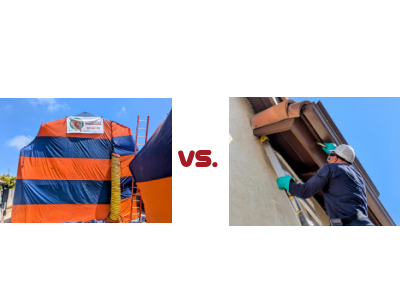Termite Local Treatments vs. Fumigation
 If you have drywood termites, there are basically two ways to treat your home: localized (or spot) treatment and fumigation. Both methods have pros and cons. Here’s how they compare:
If you have drywood termites, there are basically two ways to treat your home: localized (or spot) treatment and fumigation. Both methods have pros and cons. Here’s how they compare:
Fumigation
Pluses:
Fumigation is the most comprehensive treatment method. When done correctly, it provides 100% effectiveness. Any termites in your home—whether they’re inside wall studs, attic rafters, or wood encased in drywall or stucco—will be eliminated.
Minuses:
There are a few drawbacks:
- It’s a Hassle: You’ll need to bag up anything ingestible in your home and leave for at least two nights and three days. Pets must be boarded or taken with you. Your gas needs to be shut off and restored. Plus, you’re letting strangers into your home, and the tent signals to anyone passing by that your home is temporarily vacant.
- No Residual Protection: Fumigation only kills termites currently present. It does not prevent future infestations. Theoretically, a swarm could hit the day the tent comes down, and you might be dealing with termites again within a few years.
- Environmental Impact: The gas used in fumigation—sulfuryl fluoride—is a potent greenhouse gas, reportedly 4,000 to 5,000 times more effective at trapping heat than carbon dioxide.
Localized Treatments
Pluses:
Localized treatments are far less disruptive. You might only need to move some furniture or belongings to give access to infested areas. The treatment can often be done while you’re home, working or watching TV.
If the infested wood is accessible, localized treatment is highly effective. Termites can’t smell or detect the chemicals used (except for orange oil), so they unknowingly spread it throughout the colony. The treatment remains active in the wood for up to 10 years. Since drywood termites thrive in slightly moist wood, having residual protection in those areas is a major plus.
Minuses:
There’s one big limitation:
- Accessibility: You can only treat wood that can be reached. Less than 20% of your home’s wood is typically visible or accessible. Termites might push droppings through drywall to reveal their location, but that’s not always the case. Some attics are impossible to enter. Some homes have no exposed wood—everything is sealed behind stucco with no attic access. In those situations, if you experience a swarm, fumigation might be the only viable option.
So, Which Is Right for You?
An experienced and honest inspector will know what will and won’t work. If you’re unsure who to trust, get a few inspections. After three or four opinions, it should become clear who’s giving you real answers.
Also, maintaining a full-structure termite warranty—especially if you choose not to fumigate—allows hidden infestations to be uncovered and treated over time. If you experience a swarm and the source isn’t obvious, that might tip the scales toward fumigation.
At California Termite, we’ve inspected thousands of homes and conducted hundreds of reinspections. We’ve seen it all, and we know what’s possible—and what isn’t. Our only goal is 100% customer satisfaction. If you let us inspect your home, we promise to recommend the most effective, hassle-free, and cost-efficient solution to eliminate your termite problem.
John Gelhard


